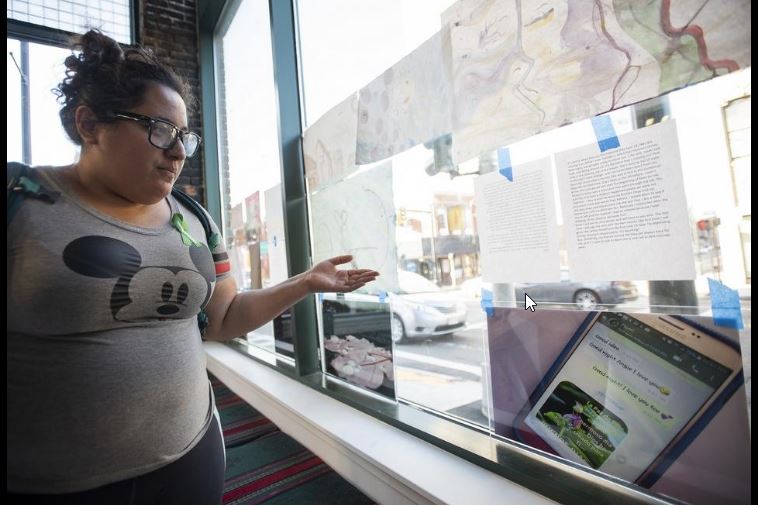Worcester Telegram & Gazette – PhotoVoice exhibit in Worcester, tells youths’ stories, struggles

Wayside’s PhotoVoice program held an exhibit in Worcester displaying 20 pieces of artwork from youth who participated in the eight-week workshop where young people are encouraged to tell a story from their life using photos and words. Read the original story as it appeared in the Worcester Telegram & Gazette or below.
By Susan Spencer
Life can be challenging enough for adolescents and young adults, and even more so if they face mental illness, lack of strong family support or emotional problems.
An art exhibit running through Tuesday at Creative Hub Worcester’s SPARK Arts, 653 Main St., features work by young people who tell their story and their struggles through photographic images.
The artwork is displayed on expansive streetside windows so it can be viewed from outside as well as inside the venue.
The 20 images, some with accompanying statements, are a retrospective show by young adults ages 14 to 26 who participated in PhotoVoice courses over the past year in Worcester, Milford, Westminster and Framingham.
The show observes Children’s Mental Health Month and National Children’s Mental Health Awareness Week.
PhotoVoice is a program of Wayside Youth & Family Support Network in Framingham, a human service agency that provides mental health counseling and support services to families, children and young adults in several communities.
At the PhotoVoice Worcester County exhibit’s opening reception Wednesday, Angelina Jimenez, 25, of Framingham, reflected on her work. The enlarged image portrayed a cellphone screenshot of a tender text message conversation with her mother, who had moved away and was in the Dominican Republic when Hurricane Irma struck, separated from her daughter in Massachusetts.
Ms. Jimenez’s mother had sent a reassuring message of peace, love and God’s presence.
“It’s about me being more responsible, me being worried,” Ms. Jimenez said, exploring her transition to living without her mother.
Ms. Jimenez has taken the eight-week PhotoVoice course five times since she was first introduced to its director, David Sebastian, at Wayside’s Tempo Young Adult Resource Center.
“I recommend it to everyone. It’s a chance to be heard,” she said.
“PhotoVoice is also a great opportunity to socialize without it being overwhelming and also bring awareness to people’s struggles,” she added. “It also doesn’t hurt that you get pizza.”
For Mr. Sebastian, 48, coordinator of mentoring art at Wayside, the Worcester exhibit comes after the estimated 65th PhotoVoice program he’s run over the past several years.
“The intent of it is to connect with young adults and have them tell a story from their life, with their voice,” Mr. Sebastian said.
Young people who participate in PhotoVoice are usually involved with state Department of Mental Health, Department of Developmental Services or Department of Children and Families, although some find the program through youth centers or school programs.
In weekly 1½-hour sessions, young adults talk about famous images and the stories they tell. Participants are then asked to make an image of their own that tells a story.
In the first few years, participants were given small digital cameras to take pictures. Now, he said, everyone uses their cellphone camera.
Participants select their most meaningful image and put words to it in an accompanying statement. Not all written stories appeared with the images in the show, however.
Mr. Sebastian said many of the young photographers didn’t want their statement displayed, disembodied, apart from themselves.
Some pieces told a story in image and words in one, such as this: A 17-year-old girl sat on cement steps, hunched over with her face buried in her hands. Written in red lipstick on her bare arms and legs were hurtful names that people called her: Fake, emo, slut, failure, stupid, ugly.
“Her writing is that,” Mr. Sebastian said of the gut-wrenching image.
Another photo was a visual representation of a young person writing out their feelings by hand in poetic bullet points on lined notebook paper, with reflective commentary in the margins.
The images can elicit strong feelings from other PhotoVoice participants, too.
Cameron Hulme, 24, of Northboro, pointed to a photo of a distressed-looking woman with a large flower in her mouth.
“I’m putting out good emotion even though I feel terrible,” he said the photo seemed to say. “That hit really hard with me.”
Mr. Hulme, a former peer specialist with Parent Professional Advocacy League in Worcester, now works with DMH, where he furthers his photography interest by shooting events and meetings.
His own PhotoVoice submission was a stark, low-angle shot down the middle of a parking garage row.
“I really like entranceways. I think they say a lot,” he said. “It says opportunity.”
PhotoVoice’s emotional skill-building and therapeutic approach to photography is a natural fit for Mr. Sebastian, who worked on crew with the performance art company Blue Man Group from 1998 to 2008.
The founders of Blue Man Group believed that experiential art was key to child development, he explained.
Mr. Sebastian said he planned to do more programs in Worcester, building on the PhotoVoice workshops that were held at Parent Professional Advocacy League, 40 Southbridge St.
But he said Worcester was “already healthier” than some communities, with a strong base of mental health resources available.
“I’m almost like a fifth wheel,” he said.

